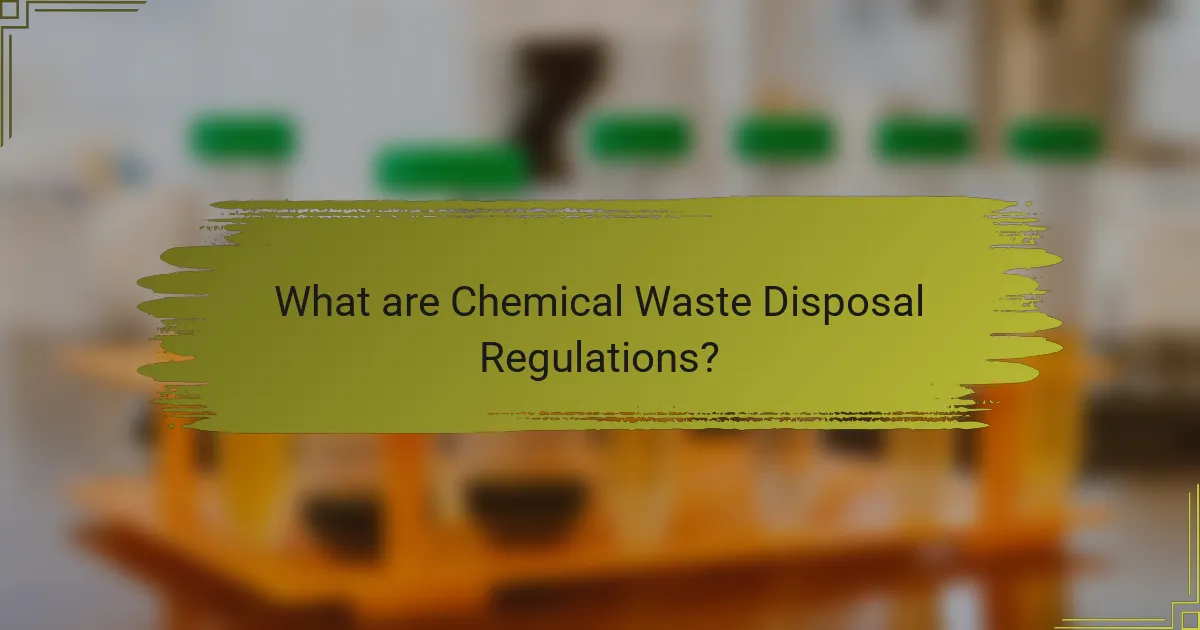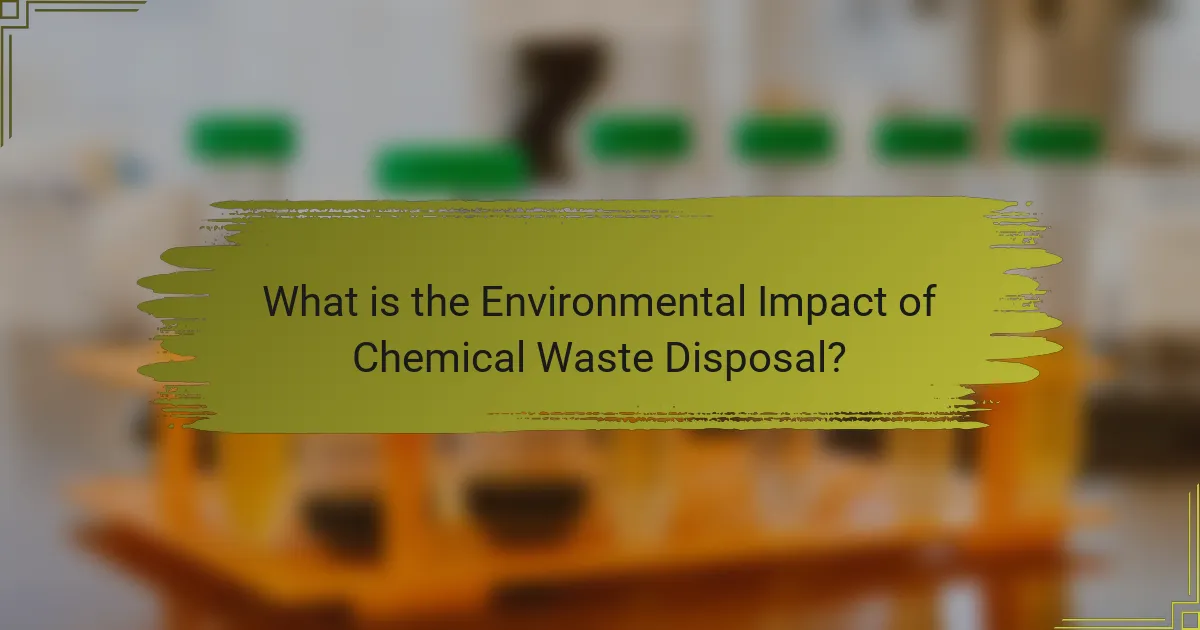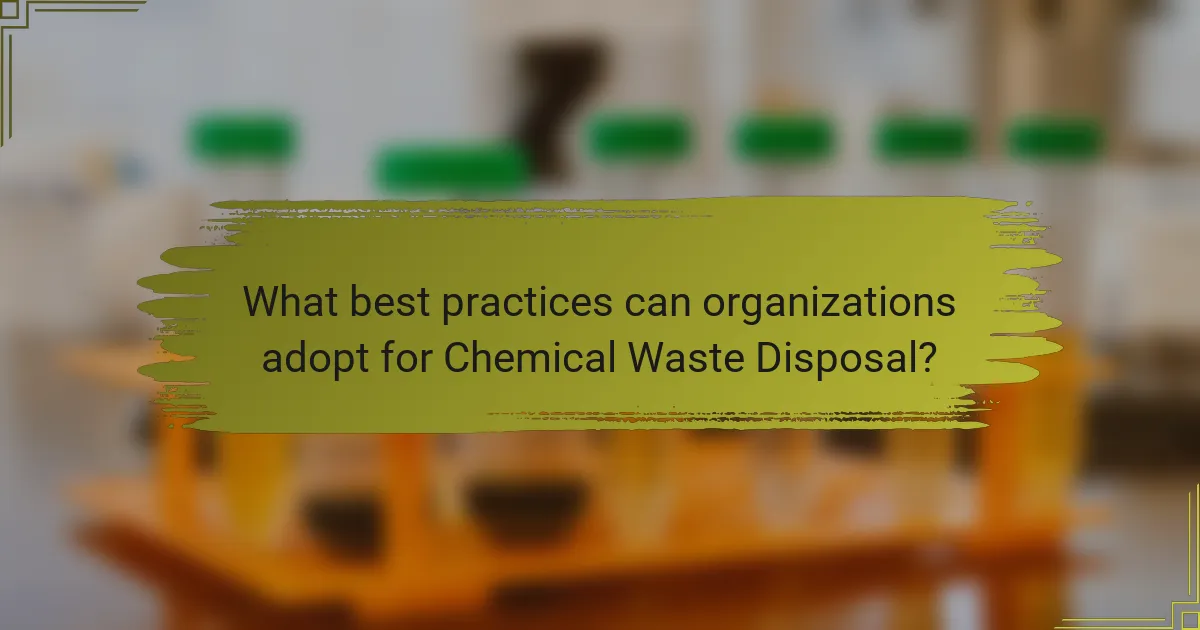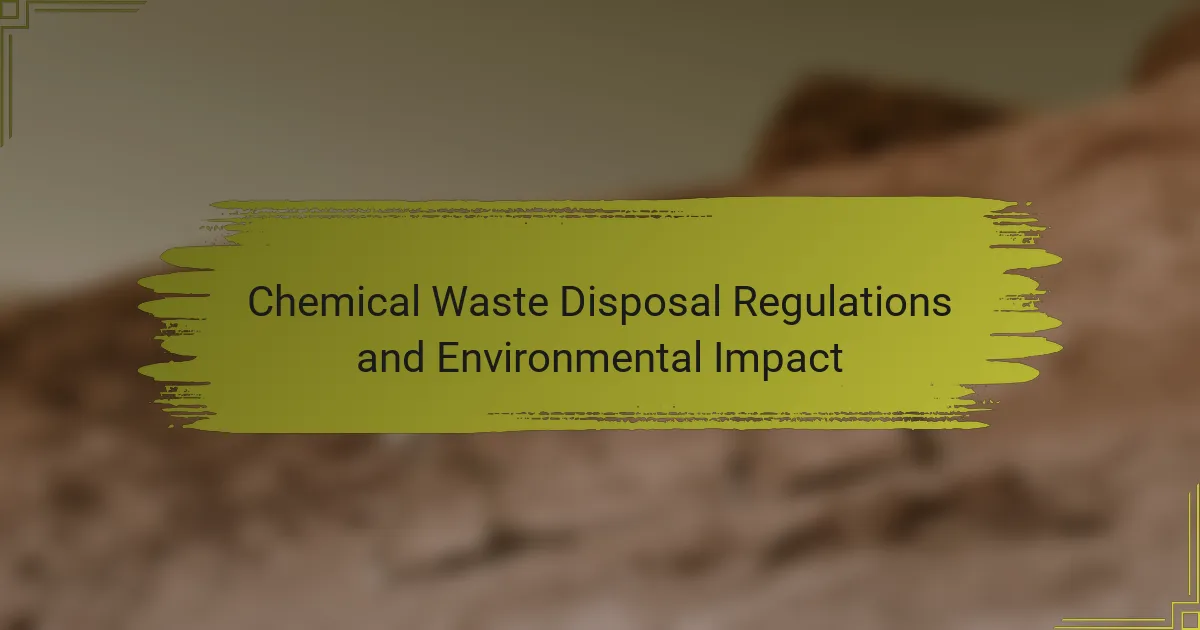
What are Chemical Waste Disposal Regulations?
Chemical waste disposal regulations are laws governing the management of hazardous chemical waste. These regulations aim to protect human health and the environment from potential harm caused by improper disposal. They outline how to identify, handle, transport, and dispose of chemical waste safely. Organizations must adhere to federal, state, and local regulations. For example, the Resource Conservation and Recovery Act (RCRA) in the United States sets standards for hazardous waste management. Non-compliance can result in significant penalties, including fines and legal action. Proper disposal methods include incineration, landfilling, or recycling, depending on the waste type. These regulations are essential for minimizing environmental contamination and ensuring public safety.
Why are Chemical Waste Disposal Regulations important?
Chemical waste disposal regulations are important to protect human health and the environment. These regulations ensure that hazardous substances are managed safely. They minimize the risk of contamination of soil and water sources. Proper disposal methods prevent toxic exposure to communities. Regulations also promote responsible waste management practices. They require businesses to follow specific guidelines for waste treatment and disposal. Compliance with these regulations reduces environmental pollution. According to the Environmental Protection Agency, improper disposal can lead to significant ecological damage.
What risks do improper chemical waste disposal pose to the environment?
Improper chemical waste disposal poses significant risks to the environment. It can lead to soil contamination, which affects plant growth and disrupts ecosystems. Contaminated soil can leach harmful substances into groundwater, compromising drinking water supplies. Aquatic ecosystems are also at risk; chemicals can enter waterways, harming fish and other wildlife. Air quality can deteriorate due to the release of toxic fumes from improperly stored chemicals. Public health risks increase as communities may be exposed to hazardous materials. According to the Environmental Protection Agency, improper disposal can result in long-term ecological damage and increased cleanup costs.
How do regulations mitigate these risks?
Regulations mitigate risks associated with chemical waste disposal by establishing strict guidelines for handling, storage, and disposal. These regulations require companies to follow specific procedures to prevent leaks and spills. They mandate regular inspections to ensure compliance and identify potential hazards early. Regulations also impose penalties for non-compliance, incentivizing companies to adhere to safe practices. Furthermore, they promote the use of safer alternatives and technologies in waste management. For example, the Resource Conservation and Recovery Act (RCRA) regulates hazardous waste to protect human health and the environment. Compliance with these regulations has been shown to reduce incidents of contamination and improve overall environmental safety.
What are the key components of Chemical Waste Disposal Regulations?
The key components of Chemical Waste Disposal Regulations include classification, labeling, storage, treatment, and disposal methods. Classification determines the type of chemical waste and its hazards. Labeling ensures that waste containers are clearly marked to indicate the contents and associated risks. Storage requirements specify how and where chemical waste must be kept to prevent leaks and accidents. Treatment methods outline processes to reduce the toxicity or volume of waste before disposal. Finally, disposal methods dictate how waste should be safely eliminated, often requiring compliance with federal and state guidelines. These components are essential for protecting human health and the environment from hazardous chemicals.
What types of chemicals are regulated under these laws?
Chemicals regulated under these laws include hazardous substances, toxic chemicals, and pollutants. Hazardous substances are defined as materials that pose a risk to human health or the environment. Toxic chemicals are specifically identified due to their potential to cause harm through exposure. Pollutants include any substances that contaminate air, water, or soil. These regulations are enforced to minimize environmental impact and protect public health. The Environmental Protection Agency (EPA) oversees the regulation of these chemicals under laws such as the Toxic Substances Control Act (TSCA) and the Clean Water Act (CWA).
How are disposal methods categorized in these regulations?
Disposal methods in chemical waste regulations are categorized into several key types. These categories typically include incineration, landfilling, and recycling. Incineration involves burning waste at high temperatures to reduce its volume and toxicity. Landfilling refers to the disposal of waste in designated sites where it is contained and monitored. Recycling encompasses processes that convert waste materials into new products. Each category adheres to specific regulatory standards to ensure environmental safety. Regulations often require permits and compliance with local and federal laws. These categorizations help manage the environmental impact of chemical waste effectively.
How do Chemical Waste Disposal Regulations vary by region?
Chemical waste disposal regulations differ significantly by region. In the United States, regulations are primarily governed by the Resource Conservation and Recovery Act (RCRA). This act establishes guidelines for hazardous waste management at the federal level. States may implement additional regulations that can be more stringent than federal requirements.
In Europe, the Waste Framework Directive sets the foundation for waste management across member states. Each country has its own regulations that align with this directive but may vary in enforcement and specific procedures. For instance, Germany has rigorous recycling and waste management laws that exceed EU standards.
Asian countries also exhibit diverse regulatory frameworks. In Japan, the Waste Management and Public Cleansing Law governs chemical waste disposal. It emphasizes recycling and proper treatment of hazardous materials. In contrast, some developing nations may lack comprehensive regulations, leading to improper disposal practices.
Overall, regional differences in chemical waste disposal regulations reflect varying environmental policies, economic conditions, and public health priorities.
What are the differences between federal and state regulations?
Federal regulations are national laws that apply uniformly across all states. They are established by federal agencies like the Environmental Protection Agency (EPA). Federal regulations set minimum standards for environmental protection. For example, the Resource Conservation and Recovery Act (RCRA) governs hazardous waste management nationwide.
State regulations, on the other hand, are laws enacted by individual states. They can be more stringent than federal laws. Each state has its own environmental agencies that create regulations tailored to local conditions. For instance, California has stricter waste disposal regulations compared to federal standards.
The primary difference lies in their scope and authority. Federal regulations provide a baseline, while state regulations can impose additional requirements. States have the power to enforce their regulations independently, as long as they do not conflict with federal laws. This dual system allows for flexibility in addressing environmental issues specific to each state.
How do international regulations compare to domestic laws?
International regulations often set broad standards for chemical waste disposal that member countries must follow. Domestic laws, however, can vary significantly based on local contexts and specific environmental needs. For example, the Basel Convention establishes international frameworks for hazardous waste management. Countries can adopt stricter regulations than those outlined in the convention. The European Union’s Waste Framework Directive exemplifies stringent domestic laws that exceed international requirements. Additionally, domestic laws may reflect unique regional environmental challenges. This leads to a patchwork of regulations that can create compliance complexities for businesses operating internationally.

What is the Environmental Impact of Chemical Waste Disposal?
Chemical waste disposal has significant environmental impacts. Improper disposal can lead to soil and water contamination. Toxic chemicals can leach into groundwater, affecting drinking water sources. Air pollution can occur from incineration of chemical waste. This can release harmful emissions, including dioxins and heavy metals. Biodiversity is also affected, as hazardous waste can harm local ecosystems. According to the U.S. Environmental Protection Agency, improper disposal of hazardous waste poses risks to human health and the environment. Thus, effective regulations are crucial to mitigate these impacts.
How does chemical waste affect soil and water quality?
Chemical waste contaminates soil and water, leading to significant environmental degradation. It introduces harmful substances, such as heavy metals and toxic chemicals, into ecosystems. These contaminants can disrupt soil structure and fertility. They can also leach into groundwater, affecting drinking water quality. Research indicates that chemical waste can reduce biodiversity in soil organisms. A study by the Environmental Protection Agency found that contaminated water can lead to health issues in humans and wildlife. Therefore, the impact of chemical waste on soil and water quality is profound and detrimental.
What are the long-term effects of chemical contamination?
Long-term effects of chemical contamination include persistent health issues and environmental degradation. Exposure can lead to chronic diseases such as cancer, respiratory disorders, and neurological damage. Contaminated soil and water can disrupt ecosystems, harming wildlife and plant life. Heavy metals and persistent organic pollutants bioaccumulate in food chains, posing risks to human health. For example, studies show that polychlorinated biphenyls (PCBs) can remain in the environment for decades, affecting both wildlife and human populations. Groundwater contamination can affect drinking water supplies, leading to long-lasting public health concerns. The economic impact includes increased healthcare costs and loss of agricultural productivity.
How do chemical spills impact local ecosystems?
Chemical spills negatively impact local ecosystems by contaminating soil and water. The introduction of hazardous substances disrupts the natural balance of flora and fauna. Aquatic life is particularly vulnerable, as toxins can lead to fish kills and reduced biodiversity. Terrestrial organisms also face threats through habitat destruction and toxic exposure. Recovery from such incidents can take years, affecting food chains and ecosystem services. Studies show that even small spills can have long-lasting effects on local biodiversity and ecosystem health. For example, a study published in Environmental Science & Technology found that chemical spills can reduce species diversity by up to 50% in affected areas.
What role do regulations play in minimizing environmental impact?
Regulations play a crucial role in minimizing environmental impact by establishing guidelines for waste management. They ensure proper disposal methods for chemical waste, reducing pollution. Regulations limit harmful emissions from industries, protecting air and water quality. They also promote sustainable practices, encouraging companies to adopt eco-friendly technologies. Compliance with regulations often leads to reduced resource consumption and waste generation. For instance, the Resource Conservation and Recovery Act (RCRA) in the U.S. governs hazardous waste management. This act has resulted in significant reductions in hazardous waste generation since its enactment. Overall, regulations are essential for safeguarding the environment and public health.
How do compliance measures enhance environmental protection?
Compliance measures enhance environmental protection by ensuring adherence to regulations that limit pollution. These measures mandate proper waste management practices, reducing harmful emissions and contaminants. For example, the Resource Conservation and Recovery Act (RCRA) in the United States establishes guidelines for hazardous waste disposal. Compliance with RCRA leads to decreased soil and water contamination. Additionally, regular inspections and monitoring promote accountability among businesses. This results in more sustainable industrial practices. Research shows that effective compliance can reduce hazardous waste generation by up to 50%. Thus, compliance measures play a crucial role in safeguarding environmental health.
What are the consequences of non-compliance for the environment?
Non-compliance with chemical waste disposal regulations leads to significant environmental consequences. It results in soil contamination, which can harm plant life and disrupt ecosystems. Contaminated soil may release toxins into groundwater, affecting drinking water supplies. Air pollution can also occur from improper waste incineration, leading to respiratory issues in humans and animals. Additionally, aquatic ecosystems suffer when hazardous waste enters water bodies, harming aquatic organisms and disrupting food chains. The Environmental Protection Agency (EPA) reports that improper waste disposal can lead to long-term ecological damage and increased health risks for communities. Thus, adherence to regulations is crucial for protecting the environment and public health.

What best practices can organizations adopt for Chemical Waste Disposal?
Organizations can adopt several best practices for chemical waste disposal. First, they should conduct a thorough waste assessment to identify the types and quantities of chemical waste generated. This assessment helps in developing a tailored disposal plan.
Next, organizations must ensure proper labeling of all chemical waste containers. Clear labels prevent accidental mixing and enhance safety. Additionally, staff training on handling and disposal procedures is crucial. Educated employees are less likely to make mistakes.
Organizations should also establish a waste segregation system. This system separates hazardous from non-hazardous waste, facilitating proper disposal methods. Regular audits of waste disposal practices can help identify areas for improvement.
Furthermore, organizations should collaborate with licensed waste disposal contractors. These professionals ensure compliance with local regulations and safe disposal methods. Lastly, maintaining accurate records of waste disposal activities is essential for regulatory compliance and accountability.
These best practices collectively minimize environmental impact and enhance workplace safety.
How can businesses ensure compliance with disposal regulations?
Businesses can ensure compliance with disposal regulations by implementing a comprehensive waste management plan. This plan should include identifying the types of waste generated and understanding applicable regulations. Training employees on proper disposal methods is essential. Regular audits can help assess compliance and identify areas for improvement. Collaborating with certified waste disposal contractors ensures adherence to legal standards. Maintaining accurate records of waste disposal activities is crucial for accountability. Businesses should stay updated on changes in regulations to remain compliant. Following these steps can significantly reduce the risk of violations and environmental harm.
What training and resources are necessary for effective disposal?
Effective disposal requires specialized training and resources. Training should include understanding local regulations and safety protocols. Personnel must learn proper handling techniques for hazardous materials. Resources needed include personal protective equipment (PPE) and disposal containers. Access to Material Safety Data Sheets (MSDS) is essential for chemical information. Facilities should provide regular training updates to ensure compliance. Additionally, waste disposal services must be reliable and licensed. These components collectively enhance effective disposal practices.
How can organizations develop a waste management plan?
Organizations can develop a waste management plan by following a structured approach. First, they should assess the types and quantities of waste generated. This involves conducting a waste audit to identify materials that can be reduced, reused, or recycled. Next, organizations must set clear waste reduction goals. These goals should be measurable and aligned with regulatory requirements.
Then, they need to establish procedures for waste segregation and storage. Proper labeling and containment are crucial for hazardous materials. Organizations should also train employees on waste management practices. This ensures everyone understands their responsibilities in the waste management process.
Finally, organizations must regularly review and update their waste management plan. This helps to adapt to changes in regulations and improve waste management practices. According to the Environmental Protection Agency, effective waste management can lead to reduced environmental impact and compliance with chemical waste disposal regulations.
What are the common challenges in chemical waste disposal?
Common challenges in chemical waste disposal include regulatory compliance, safety risks, and environmental contamination. Regulatory compliance is complex due to varying local, national, and international laws. Organizations must navigate these regulations to avoid legal penalties. Safety risks arise during the handling and transportation of hazardous materials. Mishandling can lead to accidents, posing threats to workers and the public. Environmental contamination occurs when waste is improperly disposed of. This can result in soil and water pollution, affecting ecosystems. Additionally, the high costs associated with proper disposal methods can be a barrier for many businesses. Effective waste management strategies are essential to address these challenges.
How can organizations address these challenges effectively?
Organizations can address chemical waste disposal challenges effectively by implementing comprehensive waste management strategies. These strategies should include regular training for employees on regulations and best practices. Compliance with local and federal regulations is essential to avoid penalties. Organizations should also invest in advanced waste treatment technologies. These technologies can minimize the environmental impact of disposal processes. Conducting regular audits can help identify areas for improvement in waste management practices. Collaborating with certified disposal companies ensures safe and compliant disposal of hazardous materials. Finally, developing a culture of environmental responsibility within the organization promotes proactive waste management.
What innovative solutions are emerging in chemical waste management?
Innovative solutions in chemical waste management include advanced recycling technologies, bioremediation, and waste-to-energy processes. Advanced recycling technologies can convert chemical waste into reusable materials. For example, pyrolysis breaks down plastics and chemical compounds into oil and gas. Bioremediation utilizes microorganisms to degrade hazardous substances in waste. This method has shown effectiveness in cleaning up contaminated sites. Waste-to-energy processes involve converting chemical waste into energy through combustion or anaerobic digestion. These solutions not only reduce waste but also minimize environmental impact. According to the Environmental Protection Agency, these methods can significantly lower landfill usage and greenhouse gas emissions.
Chemical waste disposal regulations are laws designed to manage hazardous chemical waste, ensuring the protection of human health and the environment. This article outlines the importance of these regulations, detailing their key components, such as classification, labeling, and disposal methods, as well as the risks associated with improper disposal. It also examines how regulations mitigate environmental impact, highlights regional variations in compliance, and discusses best practices organizations can adopt for effective waste management. Additionally, the article explores the long-term effects of chemical contamination and innovative solutions emerging in the field of chemical waste management.
